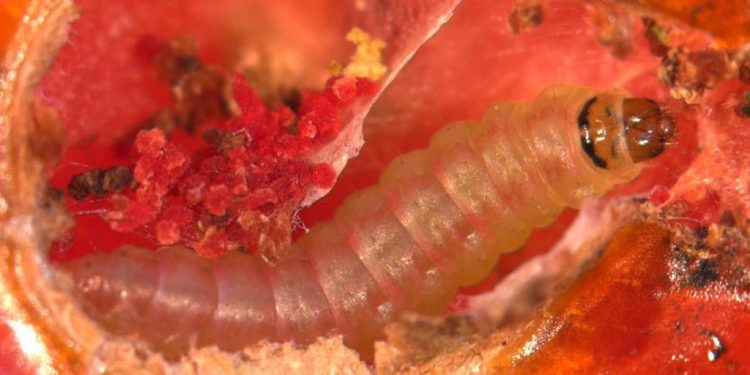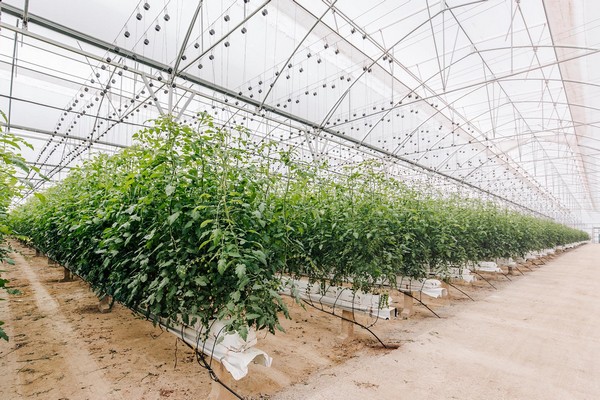South American tomato leafminer, Tuta absoluta (Meyrick, 1917) (Lepidoptera: Gelechiidae), is native to South America, but is a major invasive and quarantine pest species in Europe, Africa, and Asia. It causes extensive damage of up to 100% yield loss in tomatoes (Solanum lycopersicum) in open and greenhouse conditions. Since its first invasion in Spain in 2006, it has spread rapidly into many countries in the Mediterranean and Western Europe and further invaded Africa and Asia. In Asia, it was first recorded in August 2009 in Turkey and spread to most South and East Asian countries.
As a holometabolous insect, T. absoluta has four life stages: egg, larva, pupa, and adult. Adult females lay yellow, elliptical-shaped eggs (0.33 × 0.22 mm) individually on the upper part of the plants, including young leaves, stems, or sepals. A single female can lay approximately 260 eggs during its lifetime. The larvae damage plant leaves by mining through the mesophyll layer and penetrate into the axillary buds and fruits . The larvae go through four larval instars. The first and second instar larvae are white in color, but turn light green after the third instar. The body lengths of the second, third, and fourth instar larvae are approximately 2.8, 4.7, and 7.7 mm, respectively . Initially, thin mining galleries can be seen on the leaf, but the larvae start to feed on axillary buds and fruits when the larval density is high. Secondary infestation of pathogens also occurs through the wounds of tomato plants . Last-instar larvae usually drop onto the soil for pupation. However, pupation may also occur on leaves. Initally, pupae are green, but they later turn dark brown in color. The body length and diameter of a mature pupa are about 4.35 and 1.1 mm, respectively. Adults are approximately 6 mm long and dark gray in color, with brown and off-white color scales . Adult moths are nocturnal and usually hide during the day between the leaves. The developmental periods of egg, larva, and pupa are 4.1, 11.0, and 9.5 days, respectively, and the total life span from egg to adult is 30.2 days at 25°C ± 1°C, relative humidity 65% ± 5%, and under long daylight (16 L:8D) conditions . EPPO (2005) reported that the duration to complete a life cycle could range of 29–38 days, depending on the environmental conditions. The longevity of male and female adults are 15.8 days and 18.2 days, respectively, and the life expectancy of an egg to adult is 43 days. The oviposition period is 7.9 days, and the fecundity is 141 eggs/female. However, EPPO (2005) reported that fecundity is 260 eggs during its lifetime.
The major hosts of T. absoluta are solanaceous species, including tomato, potato, brinjal, sweet pepper, and tobacco. In particular, the European black nightshade, Solanum nigrum, is the most suitable solanaceous weed host of T. absoluta. However, it can damage many plants belonging to the Malvaceae, Amaranthaceae, Fabaceae, and Convolvulaceae, indicating that T. absoluta is a polyphagous insect pest.
In South America, T. absoluta is considered one of the most devastating pests of tomato plants. In greenhouses and open fields where tomatoes are cultivated, this pest can cause up to 80%–100% yield loss without any management efforts . T. absoluta colonizes tomato plants shortly after transplant and attains its peak infestation during the flowering–fruiting stage, with 87.50% infestation found in the early fruiting stage, followed by the rates in the early flowering, vegetative, and harvesting stages . The damage caused by T. absoluta varies according to tomato variety. In Nepal, Bajracharya et al. (2018) reported 76%–100% damage in the Karita variety, whereas 51%–75% damage was reported in the Samjhana and Srijana varieties.
Because of its vicious nature and potential to cause damage, T. absoluta is a major pest of tomato crops in most Asian countries. Its management is mostly restricted to the routine application of synthetic pesticides . Here, there are the various management methods that have been effective at controlling the spread of T. absoluta.
- 1.Cultural control: Cultural methods include the elimination and destruction of previous crop residue and infested plant parts, crop rotation with nonhost plants, growing the seedling inside a netted nursery, use of plastic trays with coco peat media, not growing secondary host plants around the farm, and performing regular weeding to reduce T. absoluta infestation. Additionally, using plastic mulch also helps identify the pupae and deter pupation.
- 2.Mechanical control: Hand picking, sticky traps, and insect exclusion nets are commonly used to control T. absoluta. Sah et al. (2017) indicated that seedlings growing inside nylon nets reduced T. absoluta infestation by 84%, and growing tomatoes with net protection helped decrease the pest population by 72.9%. They also reported that tomato production in net houses was 32% higher than that in open fields.
- 3.Physical control: Farmers use various traps, including light traps, sex pheromone traps (TLM lure in Wota-T traps, funnel trap, and delta trap), and locally prepared water traps (with detergent solution) for monitoring and controlling T. absoluta in the field.
- 4.Biological control: Neem-based pesticides, Bacillus thuringiensis, and Metarhizium anisopliae are used to control T. absoluta in the field. Among these three, neem-based pesticides are more effective at decreasing leaf damage (41.56%) than B. thuringiensis (27.39%) and M. anisopliae in fields . However, this study did not provide details about the concentration, application methods, and product information of the biological controls. Similarly, cardamom essential oil was found to be efficacious against the eggs and early instar larvae . A predatory bug, Nesidiocoris tenuis, an egg parasitoid, Trichogramma achaeae , and entomopathogenic nematodes, Steinernema carpocapsae, S. feltiae, and Heterorhabditis bacteriophora, were effectifve at controlling T. absoluta in the field .
- 5.Chemical control: Most farmers use synthetic insecticides due to their immediate and observable impact on the pest populations. However, T. absoluta has already developed high resistance to abamectin, organophosphate, and pyrethroid insecticide products . Some of the chemicals most commonly used in vegetable production systems around the world are spinosad, emamectin benzoate, chlorantaniliprole, chloropyriphos, and cypermerthrin. Among them, spinosad has shown greatest efficacy against T. absoluta larvae.
Photo: EPPO (2024) EPPO Global Database. https://gd.eppo.int
Reference: , , , , & (2023) Biology, distribution, and management of invasive South American tomato leafminer, Tuta absoluta (Meyrick) (Lepidoptera; Gelechiidae), in Asia. Archives of Insect Biochemistry and Physiology, 114, e22056. https://doi.org/10.1002/arch.22056












